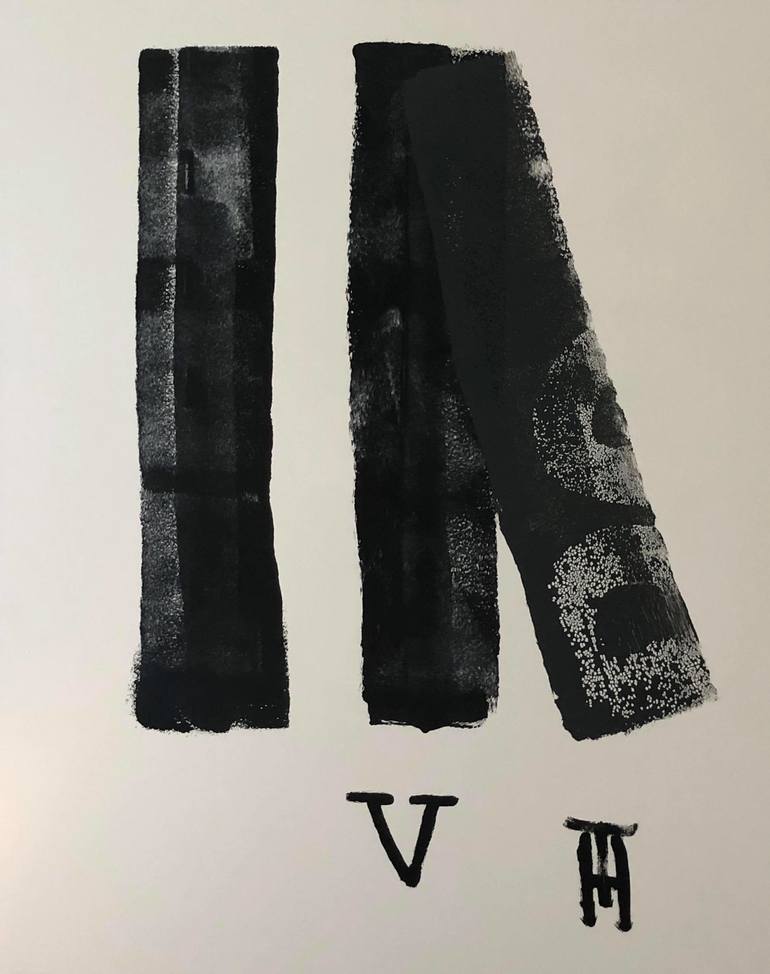


VIEW IN MY ROOM
EUCLID'S FIFTH Painting
Denmark
Painting, Oil on Canvas
Size: 31.5 W x 39.4 H x 0.7 D in
Ships in a Box
Shipping included
14-day satisfaction guarantee
About The Artwork
Euclid lived in ancient Greece around 350 - 250 BC. and is the author of a treatise entitled Elements. It is the second most frequently printed work in history, next only to the Bible. But in fact, Euclid’s work was a bible for almost 2000 years. He presented all the mathematics known to his time, and he did so by first fixing a set of basic postulates (rules to be taken for granted) and then inferring all the results from these postulates. Euclid’s postulates for geometry express basic properties, e.g. that you can draw just one straight line between two given points. The fifth postulate states that if you take a line and a point outside the line, then you can draw just one line through the point which is parallel to the first line, i.e. which does not intersect that line. If you draw another line, it will intersect the first (and second) line. Over a period of two thousand years, speculation arose whether the fifth postulate could be inferred from the other four, or it would be possible to replace by with alternative axiom yielding a different kind of geometry. Around 1830 it finally turned out that the fifth is independent from the others and that other possible geometries exist. One can think of the geometry on the surface of a sphere, though strictly speaking this is not an example, as the other four axioms are not all true. But other examples exist known as hyperbolic geometry. Euclid’s Elements also contain a number of now classic proofs some of which are portrayed in the works. This work follows the same recipe as the Rules series, i.e. the first layer consists of a number of geometric shapes, barely visible behind the second layer with the main motive. This work is part of the series THEOREMS AND PROOFS. The works illustrate – directly or indirectly – a theorem with a beautiful proof, according to the criteria put forth by the mathematician Hardy in his classical book A Mathematician's Apology: surprise combined with something inevitable, economy and depth.
Details & Dimensions
Painting:Oil on Canvas
Original:One-of-a-kind Artwork
Size:31.5 W x 39.4 H x 0.7 D in
Frame:Silver
Ready to Hang:Not applicable
Packaging:Ships in a Box
Shipping & Returns
Delivery Time:Typically 5-7 business days for domestic shipments, 10-14 business days for international shipments.
Handling:Ships in a box. Artists are responsible for packaging and adhering to Saatchi Art’s packaging guidelines.
Ships From:Denmark.
Have additional questions?
Please visit our help section or contact us.
Denmark
In our works we try to convey the aesthetics of deep ideas in poetry, philosophy and mathematics in a manner which is also visually appealing. Some works start out from a text, others from a theorem or a proof. They usually contain multiple layers of both paint and ideas. The result in each case is hopefully a work which can be approached and appreciated by means of intuition and immediate dialog, but which will also lend itself to increasing reflection and surprise over time. Our materials and production of the paintings are largely industrial, proceeding as one would when painting a building or a piece of furniture. We were not consciously inspired by any one particular artist initially. However, we saw in hindsight a resemblance with Franz Kline and Mark Rothko and accepted the herritage along the way.
Thousands Of Five-Star Reviews
We deliver world-class customer service to all of our art buyers.
Global Selection
Explore an unparalleled artwork selection by artists from around the world.
Satisfaction Guaranteed
Our 14-day satisfaction guarantee allows you to buy with confidence.
Support An Artist With Every Purchase
We pay our artists more on every sale than other galleries.
Need More Help?